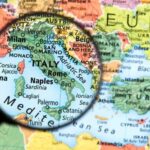Italy, a popular destination for travelers around the world, has been closely monitoring and adjusting its travel restrictions in response to the ongoing COVID-19 pandemic. The question on everyone’s mind is: is Italy changing travel restrictions? As the situation continues to evolve, it is essential for both tourists and locals to stay informed about the latest updates and regulations in place.
Since the outbreak of COVID-19, Italy has implemented various measures to control the spread of the virus, including imposing travel restrictions and quarantine requirements for visitors entering the country. These restrictions have had a significant impact on tourism and the economy, leading to a decline in international travel to Italy.
As Italy navigates through the challenges posed by the pandemic, it is crucial to understand how these changing travel restrictions are affecting tourism. By analyzing past measures and recent developments in Italy’s travel policies, we can gain insight into what the future holds for travelers planning a visit to this beautiful European destination.
Overview of Italy’s COVID-19 Situation
Current Status
As of now, Italy has been experiencing a fluctuation in the number of COVID-19 cases. The country was one of the early epicenters of the pandemic in Europe, but stringent measures were implemented to control the spread. However, with the emergence of new variants and the relaxation of restrictions, there is a concern about a potential resurgence. The government has been closely monitoring the situation and adjusting protocols accordingly.
Vaccination Progress
Italy has made significant progress in its vaccination rollout, with a considerable portion of the population already vaccinated. The government has been actively promoting vaccination campaigns to achieve herd immunity and prevent future outbreaks. This progress is crucial in determining the course of travel restrictions in the country, as authorities consider easing measures for vaccinated individuals while maintaining vigilance against new variants.
Challenges Ahead
Despite progress in vaccinations, Italy is still facing challenges regarding vaccine hesitancy in certain regions and communities. Additionally, concerns remain about reopening borders for international travel and balancing economic recovery with public health priorities. As Italy navigates through these challenges, it is essential to monitor how these factors may influence future decisions on travel restrictions to ensure the safety of both residents and visitors alike.
Analysis of Italy’s Past Travel Restrictions
Italy has had a tumultuous journey with regard to travel restrictions in the past. As one of the countries initially hit hard by the COVID-19 pandemic in early 2020, Italy was forced to implement strict measures to contain the spread of the virus.
At that time, Italy imposed a nationwide lockdown, closed its borders, and prohibited non-essential travel both domestically and internationally. These stringent restrictions had a significant impact on the country’s tourism industry, which relies heavily on international visitors.
As the situation gradually improved and COVID-19 cases decreased, Italy began easing its travel restrictions in mid-2020. The country adopted a color-coded system to categorize regions based on their risk level, allowing for targeted measures to be implemented where needed.
However, despite these efforts, sporadic outbreaks continued to pose challenges for Italy’s travel sector. The government had to regularly reassess and adjust restrictions based on the prevailing health situation, leading to uncertainty for travelers and businesses alike.
Overall, the analysis of Italy’s past travel restrictions highlights the country’s proactive approach to managing the COVID-19 crisis while balancing economic concerns with public health priorities. Although there were setbacks along the way, Italy demonstrated resilience in adapting its policies to evolving circumstances. Moving forward, it will be crucial for Italy to learn from these experiences as it navigates through changing travel restrictions amid new variants of the virus and global uncertainties.
| Italy’s Past Travel Restrictions | Analysis |
|---|---|
| Nationwide lockdown and border closures | Significantly impacted tourism industry |
| Implementation of color-coded system | Allowed targeted measures but faced challenges with outbreaks |
| Proactive approach and policy adaptation | Demonstrated resilience amid uncertainties |
Recent Developments in Italy’s Travel Restrictions
Italy has been closely monitoring and adjusting its travel restrictions in response to the ever-evolving COVID-19 situation. As of late, there have been notable developments in Italy’s travel restrictions that are worth exploring. These changes are crucial for travelers planning trips to Italy and for the tourism industry as a whole.
Updates on Entry Requirements
In recent months, Italy has implemented new entry requirements for travelers, including mandatory testing and quarantine protocols. The country has also introduced a digital passenger locator form to track visitors and their movements within Italy. These measures aim to curb the spread of the virus and ensure the safety of both tourists and residents.
Vaccination Policies
Italy is at the forefront of vaccination efforts, with a significant portion of its population already vaccinated. As a result, the country has started relaxing some travel restrictions for vaccinated individuals. This includes exemptions from certain testing requirements or quarantine rules. Travelers should stay updated on these policies to understand how they may affect their trip to Italy.
Evolving Situation
It is important to note that Italy’s travel restrictions are subject to change based on the current COVID-19 situation. As new variants emerge and cases fluctuate, the Italian government may adjust its policies accordingly. Travelers must stay informed through official channels and consult with local authorities before embarking on their journey to Italy. The key is flexibility and awareness when it comes to navigating through Italy’s changing travel restrictions.
Impact of Italy’s Changing Travel Restrictions on Tourism
Italy’s changing travel restrictions have had a significant impact on the tourism industry in the country. With the COVID-19 situation evolving rapidly, Italy has been implementing various measures to contain the spread of the virus while also trying to revive its tourism sector. Here are some key points to consider regarding the impact of Italy’s changing travel restrictions on tourism:
- Reduction in Tourist Numbers: The constant changes in travel restrictions, including quarantine requirements and testing mandates, have deterred many tourists from visiting Italy. This has led to a significant decrease in tourist numbers, affecting businesses that rely heavily on tourism for revenue.
- Economic Challenges for Tourism Sector: The fluctuating travel restrictions have posed economic challenges for the tourism sector in Italy. Many hotels, restaurants, and tour operators have struggled to stay afloat due to the uncertainty surrounding travel regulations.
- Shift in Tourist Behavior: The changing travel restrictions have also resulted in a shift in tourist behavior. Many travelers are opting for destinations with more stable regulations or choosing alternative forms of travel such as road trips or domestic tours to avoid any last-minute disruptions.
Despite these challenges, Italy remains a popular destination for travelers around the world. As the country continues to navigate through the pandemic, it is essential for tourists to stay updated on the latest travel restrictions and guidelines issued by Italian authorities to ensure a safe and enjoyable visit.
Comparison With Other European Countries’ Travel Restrictions
When considering travel restrictions in Italy, it is important to also look at how other European countries are handling the situation. The COVID-19 pandemic has affected all nations differently, leading to varying measures being implemented by governments. Below is a comparison of Italy’s changing travel restrictions with some key European countries:
- France: France has also seen changes in its travel restrictions throughout the pandemic. As of now, travelers from certain countries are required to provide a negative COVID-19 test result upon arrival. Quarantine measures may apply depending on the traveler’s origin.
- Spain: Spain has been implementing restrictions on travelers from high-risk countries and regions. Entry requirements and quarantine measures have been adjusted based on the evolving situation of the virus.
- Germany: Germany has been regularly updating its list of risk areas and implementing travel restrictions accordingly. Travelers entering Germany from high-risk areas may be required to undergo testing and quarantine upon arrival.
It is evident that Italy is not the only country experiencing changes in travel restrictions due to the COVID-19 pandemic. Each country is adapting its measures based on the progression of the virus and international guidelines. Travelers should stay informed about the latest updates from multiple sources before planning their trips.
- Switzerland: Switzerland has also imposed various travel restrictions during the pandemic, including mandatory quarantine for travelers coming from certain regions with high infection rates.
- Austria: Austria has implemented entry requirements for travelers from high-risk areas, including mandatory testing and quarantine measures. These restrictions are subject to change based on the current COVID-19 situation.
By comparing Italy’s changing travel restrictions with those of other European countries, it becomes clear that a coordinated approach is necessary to control the spread of COVID-19 while minimizing disruptions to international travel. The situation remains fluid, and travelers must be prepared for potential adjustments to regulations before embarking on their journeys across Europe amidst this challenging time.
Future Prospects for Italy’s Travel Restrictions
Italy has been closely monitoring the evolving situation regarding the COVID-19 pandemic and adjusting its travel restrictions accordingly. As the country strives to strike a balance between ensuring public health and reviving its tourism industry, there is much speculation on how Italy will continue to adapt its travel restrictions in the future.
One key factor that is influencing Italy’s approach to travel restrictions is the vaccination rollout. As more people in Italy and around the world are getting vaccinated, there is hope that this could lead to a relaxation of travel restrictions. However, concerns about new variants of the virus may prompt Italy to maintain or even tighten travel restrictions in certain cases.
Another consideration for Italy’s future travel restrictions is the potential for a coordinated approach with other European countries. As part of the European Union, Italy may work towards harmonizing travel rules within the EU to facilitate smoother movement across borders while still prioritizing public health measures. This could mean more standardized protocols for testing, quarantine, and vaccination requirements for travelers entering Italy.
The future prospects for Italy’s travel restrictions will ultimately depend on various factors such as the epidemiological situation, vaccination rates, and international developments related to COVID-19. Travelers planning to visit Italy in the near future should stay informed about any updates or changes to travel restrictions and be prepared to comply with them for a safe and enjoyable experience.
Tips for Travelers Planning to Visit Italy Amidst Changing Restrictions
Italy is known for its stunning landscapes, rich history, and delicious cuisine, making it a popular destination for travelers from around the world. However, with the ongoing COVID-19 pandemic, Italy’s travel restrictions have been constantly evolving to ensure the safety of both residents and visitors. So, is Italy changing travel restrictions to adapt to the current situation?
As of now, Italy has implemented various measures to control the spread of COVID-19, including mandatory mask-wearing in public spaces, social distancing guidelines, and health screenings at airports. It is essential for travelers planning to visit Italy to stay updated on the latest travel restrictions and guidelines set by the Italian government. These restrictions may vary depending on the region you are visiting and can change rapidly based on the local epidemiological situation.
One of the recent developments in Italy’s travel restrictions is the introduction of a “Green Pass” system. This digital certification shows proof of vaccination, a negative COVID-19 test result, or recovery from the virus. Travelers should familiarize themselves with these requirements and ensure they have the necessary documentation before their trip. Additionally, it is advisable to check with airlines and accommodations regarding their specific COVID-19 protocols to avoid any last-minute surprises.
| Travel Tip | Description |
|---|---|
| Stay Updated | Regularly check official sources for travel advisories and updates on Italy’s travel restrictions. |
| Get Vaccinated | If eligible, get vaccinated against COVID-19 before traveling to Italy to protect yourself and others. |
| Travel Insurance | Purchase comprehensive travel insurance that covers COVID-related issues such as cancellations or medical expenses. |
Conclusion
Italy has been closely monitoring and adjusting its travel restrictions in response to the evolving COVID-19 situation. As the country continues to navigate the challenges presented by the pandemic, it is crucial for travelers to stay informed about any updates or changes that may affect their plans. It is clear that Italy’s changing travel restrictions have had a significant impact on tourism, with many travelers facing uncertainty and disruption in their travel plans.
The recent developments in Italy’s travel restrictions indicate a cautious approach towards reopening borders and allowing international travel. This cautious approach is understandable given the need to prioritize public health and safety. However, it also highlights the challenges faced by both travelers and the tourism industry as they adapt to these changing circumstances.
As Italy continues to navigate the uncertainties of the pandemic, travelers planning to visit the country should stay updated on any changes to travel restrictions and requirements. It is important to be flexible and prepared for potential disruptions, such as last-minute quarantine requirements or changes in entry protocols. By staying informed and following guidelines from authorities, travelers can help ensure a safe and smooth travel experience amidst Italy’s changing travel restrictions.
Frequently Asked Questions
Are There Any Restrictions to Travel to Italy?
Travel to Italy is currently subject to restrictions due to the COVID-19 pandemic. Non-essential travel from certain countries may be restricted, and travelers may be required to quarantine upon arrival or provide proof of vaccination or negative testing. It is important to check the latest travel advisories before planning a trip.
What Is Required for a US Citizen to Visit Italy?
For a US citizen to visit Italy, a valid passport is required. Additionally, travel restrictions due to COVID-19 may necessitate proof of vaccination or negative testing, completion of health declaration forms, and adherence to any quarantine requirements upon arrival. Checking with the Italian consulate or embassy for the latest information is advisable.
Is Italy Safe for American Tourists Right Now?
Generally speaking, Italy is considered safe for American tourists. However, like any foreign country, tourists should exercise caution and remain vigilant against petty crimes such as pickpocketing in popular tourist areas. It is also important to stay informed about any local safety concerns or health advisories that may affect travel plans.

I’m a passionate traveler, writer, and Italophile. My fascination with Italy’s history, art, and culture has led me on countless adventures across the Italian landscape. Through “I Live Italy,” I share my love for this extraordinary country and aims to inspire others to explore its boundless beauty.




